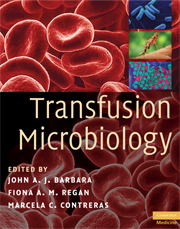Book contents
- Frontmatter
- Contents
- List of contributors
- Foreword
- Preface
- Acknowledgements
- Glossary
- Introduction: Transfusion-transmitted infections, then and now
- Section 1 Agents
- 1 Hepatitis viruses
- 2 Antibody to hepatitis B core antigen
- 3 Herpes viruses
- 4 Retroviruses
- 5 Parvovirus B19 (human erythroviruses)
- 6 Emerging viruses in transfusion
- 7 Bacterial contamination in blood and blood components
- 8 The protozoan parasites
- 9 Prion diseases
- Section 2 Selection and testing
- Section 3 Surveillance, risk and regulation
- Index
- Plate section
- References
6 - Emerging viruses in transfusion
from Section 1 - Agents
Published online by Cambridge University Press: 12 January 2010
- Frontmatter
- Contents
- List of contributors
- Foreword
- Preface
- Acknowledgements
- Glossary
- Introduction: Transfusion-transmitted infections, then and now
- Section 1 Agents
- 1 Hepatitis viruses
- 2 Antibody to hepatitis B core antigen
- 3 Herpes viruses
- 4 Retroviruses
- 5 Parvovirus B19 (human erythroviruses)
- 6 Emerging viruses in transfusion
- 7 Bacterial contamination in blood and blood components
- 8 The protozoan parasites
- 9 Prion diseases
- Section 2 Selection and testing
- Section 3 Surveillance, risk and regulation
- Index
- Plate section
- References
Summary
Introduction
The availability of a broad range of molecular biological techniques following the development of polymerase chain reaction (PCR) had a major impact on the discovery of new viruses, often outside the classical context of a clinical disease. Conversely, the same techniques were used to examine diseases of unknown aetiology where a viral involvement was suspected and a virus was identified, long, controversial, and often inconclusive data were assembled by investigators to demonstrate the connection between this viral agent and the original disease such as human herpes virus 8 (HHV-8) in multiple myeloma. Besides the virological issues, in such circumstances, relevance to transfusion was invariably examined, irrespective of pathogenicity (Allain, 2000).
In the past ten years, several extra- and intra-cellular viruses have been discovered or re-discovered and only one, West Nile virus (WNV), led to blood screening, the other viruses are at the present time considered not worthy of screening due to lack of pathogenicity (GBV-C/HGV, TTV, SEN-V) and/or high prevalence (TTV, SEN-V), or lack of evidence of transfusion-transmissibility despite clear pathogenicity, for example HHV-8. Another issue explaining the reluctance to screen was that most viruses needed genomic amplification methods for detection (please refer to Chapter 14) and this added substantially to the complication and costs of current procedures for blood testing (Allain et al., 2002).
Despite these limitations of scope and practicality, it is important in the context of transfusion microbiology to be aware of these viruses whose features and pathogenicity can be better understood in the future, and this may influence future policy.
- Type
- Chapter
- Information
- Transfusion Microbiology , pp. 75 - 86Publisher: Cambridge University PressPrint publication year: 2008



